
Ronn Sutton on courtroom drawing and more
It’s a given that Ronn Sutton’s art has been enjoyed by thousands of readers. Still, it’s quite likely that the number of people who’ve seen but one of the images he’s recently produced equals–if not actually exceeds–the total number of fans who’ve enjoyed his art over the course of his storied career in comics. And that’s due to the fact that Sutton’s been working as a courtroom artist, producing a series of portraits of the defendants in some of Canada’s biggest trials of the past few years.
As you might imagine, putting a human face to various criminal acts is a gig that’s demanding, deadline-driven…and distinctly different from his comics work, even if those books might have had such ominous titles as Elvira, Mistress of the Dark and Fear Agent.
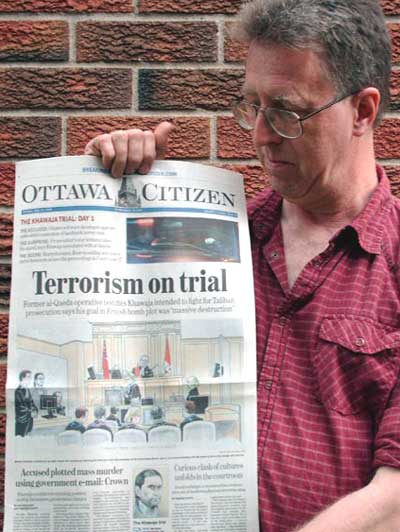
Ronn Sutton: I got a call from the CanWest Network asking if I was interested. I’m primarily doing these courtroom sketches for The Ottawa Citizen, but its part of the CanWest Network, which is more than a dozen newspapers nationwide plus TV stations. They share artwork, so potentially my art could appear in a number of their publications.
I know that friends and relatives in other cities have seen my art on their TVs and newspapers. I’ve been doing courtroom sketches for four or five years now. My first assignment was to draw Renee Michaud, who had murdered a couple who were complete strangers to him. He had five tattoos on his face, including two large handguns tattooed on his forehead. You almost have to admire that dedication to evil to have guns tattooed onto your face. Almost.
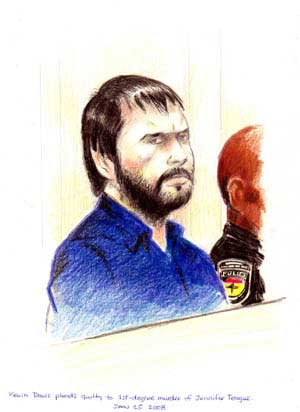
RS: First, it’s a drawing, not a photograph, so there’s room for some visual interpretation. But I am extremely focused on the face and am trying to draw the person as accurately as possible. Under these circumstances, I consider myself a type of reporter. It’s not the same as drawing from a model in art class. Sometimes you’re trying to capture a fleeting moment that has great significance.
Almost every case I get sent to is a very high-profile murder case. My assignments fit into two categories: the arraignments and the trials. An arraignment is when a person is first charged with a crime and must appear before a judge to set a trial date. This is a lightning-fast court appearance of literally 30 to 60 seconds. In these cases, I get a call out of the blue from the newspaper telling me to get to the courthouse as fast as possible. There are times that I’m on my way and still don’t know the name of the accused or what courtroom he’ll appear in. I have to focus on the face and photograph it in my mind because I can barely block out shapes in pencil on paper in that time. The drawing is only in my head at that point, and it has to be completed immediately after. I’ve gotten very good at it.
With the trial drawings, I usually know about them in advance and will be there for hours, or the whole day. The colour artwork is completed entirely in the courtroom while the trial goes on around me. In the case of very notorious trials, the newspaper may send me back a number of times to capture various witness testimonies, and usually the day of the verdict as well.
Often, police security is high. During the trial of Momin Khawaja [the first man charged with terrorism in Canada], I had to go through metal detectors and have my portfolio and personal items x-rayed. There were police with machine guns and bomb-sniffing dogs, and even police snipers on the courthouse roof. The day I drew the testimony of al-Qaeda member Mohammed Babar, he was surrounded by armed police officers the entire time he was on the stand.
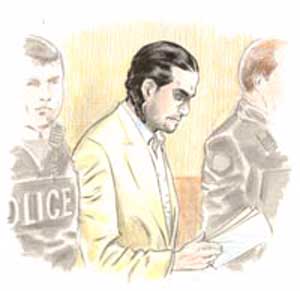
RS: I’m just trying to be a visual reporter. I’m trying to draw mostly what’s in front of me, without any preconceived notions. You don’t want to distort facts to match your drawing–it absolutely has to be the other way around. The newspaper has me there because cameras aren’t allowed in the courtroom, so I’m the eyes of the nation. I want to deliver an image that is as accurate as possible, reflecting the faces and atmosphere of the court.
BB: How difficult is this job, and what kind of variables have an affect on your ability to capture the people involved in these dramas?
RS: There’s limited seating in courtrooms, so I get there as early as possible and stake out the best seat possible. Unfortunately, sometimes the sight-lines are terrible, even in the best seats. On some occasions the person I’m assigned to draw doesn’t want to be drawn. One man turned away and tried to cover his face until his lawyer advised him to behave. Randy Parrish, a pedophile who was convicted of the arson fire that killed two children, “mugged” for me the entire time I tried to draw him. He was literally making goofy faces at me, and then he started gesturing for me to show him my drawing. I didn’t, of course.
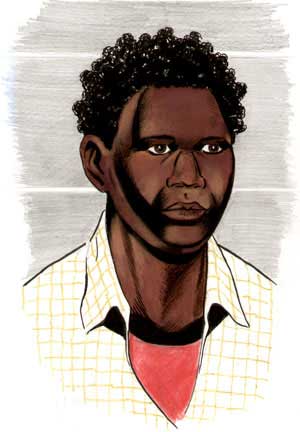
RS: Well, it’s all drawing. Obviously I have a certain facility in drawing the human figure from having done so much comic book work. I’ve always prided myself on my sense of design and the readability of my images. I hope I apply that to my court drawings as well.
BB: What about the reverse? Do you think that your court room sketching has had, or will have, any real impact on your comics work?
RS: Certainly any drawing from life is beneficial. I try not to exaggerate or fall into any comic book stylizations or shorthand when doing court art. I want no preconceived notions; I’m trying to be a visual reporter recording the persons and situations as accurately as I can under the circumstances. Some of this real-world drawing comes back into whatever fantasy work I’m creating.
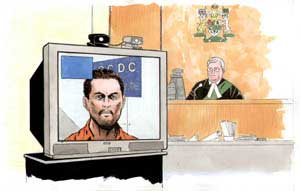
RS: One thing I’m always struck by is the immediacy of it all. I do a drawing and then it’s in print on the front page the very next morning, or even appearing on TV news that same day. Being in the courts tends to be a lesson in humanity. I’ve seen some unusual things, like a fistfight break out between police and prisoner. On one occasion, I sat next to a man who admitted to twelve separate murders.
From a technical standpoint, I have to work in colour very spontaneously, without any thought of technique or style. I work on a mix of pure instinct and professional ability. It becomes automatic drawing. Afterward, I look at some of my own work and I surprise myself at the colour choices and colour-blending. If I had time to think out what I was doing, most drawings would likely get over-analyzed and not be nearly as good.
BB: What else do you have going on these days? For instance, will we be seeing some new comics from you, or perhaps from you and Janet, some time soon?
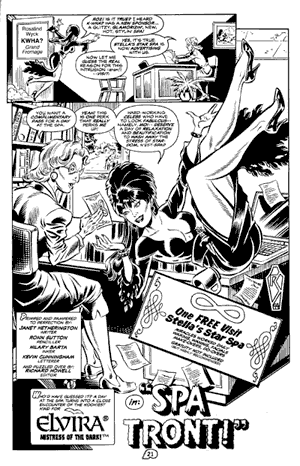
I’m currently penciling a Munden’s Bar story that Hilary will ink for Mike Gold’s www.comicmix.com site. After that, Hilary and I are supposed to be doing a strip for Asylum of Horrors from Asylum Press. I think I’m drawing a story for Imperion Comics’ Trailerpark of Terror. And I’ve committed to doing a dozen single full-page illustrations of The Phantom for a Moonstone project. I’m starting to develop some concepts as well for a larger horror project.
My longtime partner, Janet L Hetherington, is doing less comic writing at the moment and concentrating on some screenwriting projects. But we’ll work on some comic projects together again soon. She is a wonderfully original writer and completely free of cliche or imitation.
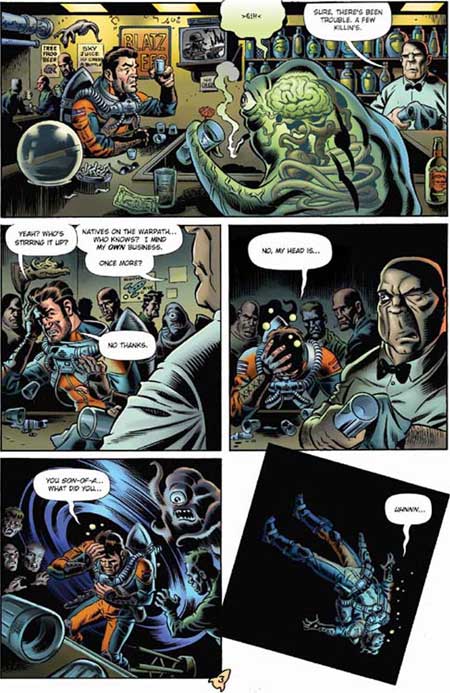
RS: The most obvious answer is I get to work in colour and draw from life, neither of which happens in my comics work. But it’s a different world. It’s exciting, but a nerve-wracking challenge. You only get one shot at a court sketch, trying to do your best work but not knowing how long you have. At any moment, the judge might adjourn for the day without warning. My comic work is very methodical, working in isolation in my studio. The courtroom is a public forum, and in an effort to blend in, I wear a suit, although it’s not required. A couple of times I’ve been approached and asked if I was a lawyer. I’ve joked with friends that I should ask for a cash retainer and run. [General laughter]
BB: How about making comics, and art in general? Why do you do it, and what does it provide you with, personally or professionally?
RS: I don’t know how not to draw and create. With comics, I’ve been doing them in one venue or another for decades now. For a long time I wrote, penciled, inked and lettered all my own stories, but about 12 years ago, I got turned into a penciler. I’ve made huge strides in my drawing by focusing on just penciling, as opposed to being “jack of all trades, master of none”. I’ve improved enormously. With every strip I try to out-do my previous effort.
BB: Anything else you’d like to add before I let you get back to work?
RS: I’ve been fortunate that the newspapers have been so happy with my court sketches. This year I’ve been doing one every week or two it seems. It’s a nice break from comics. I’ve already mentioned a number of comic projects I’ve been involved with lately. I’m hoping to start several horror comic assignments shortly. And I’m starting to develop a larger horror comics project on my own.
